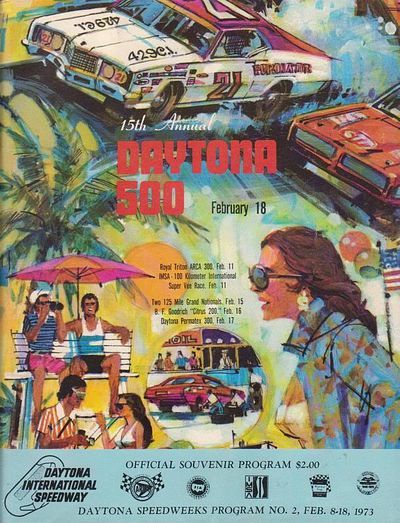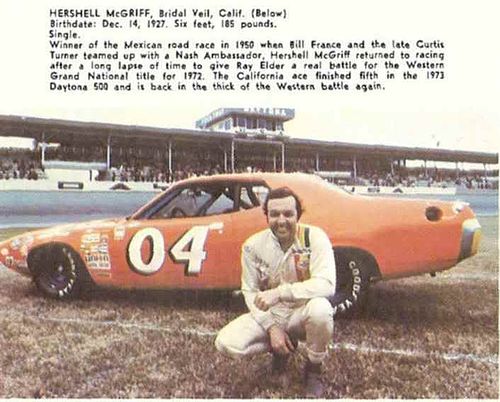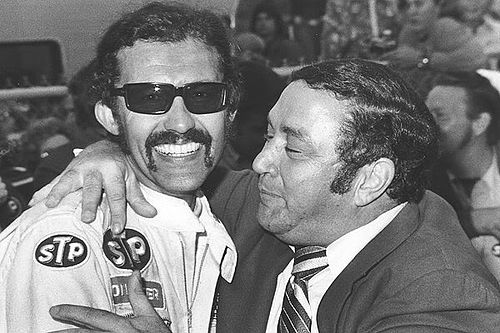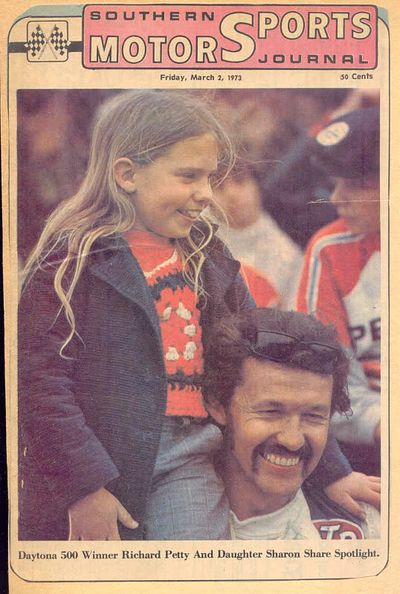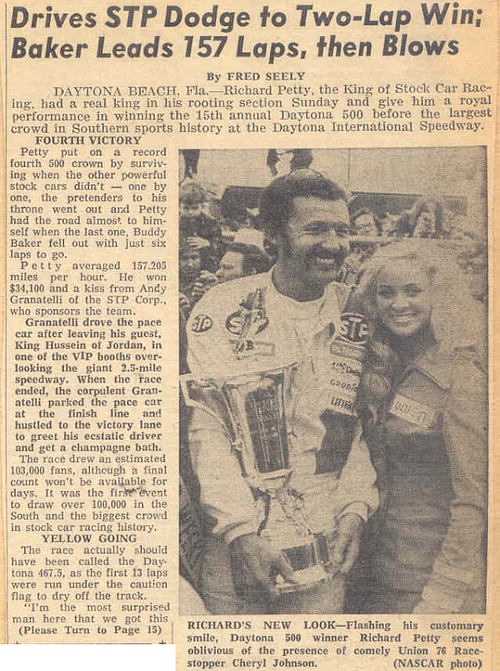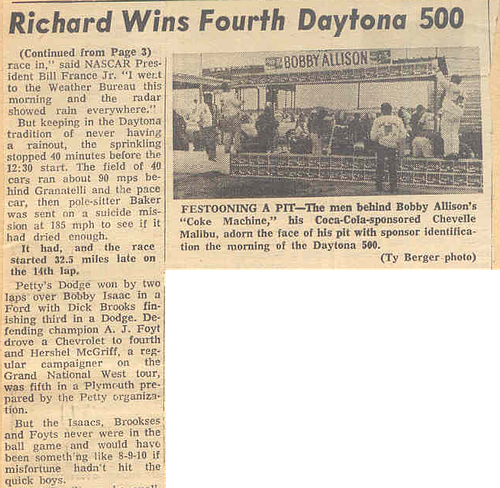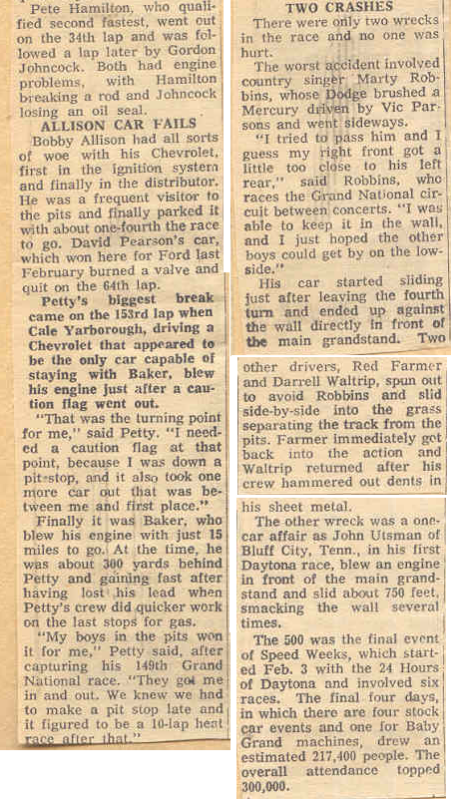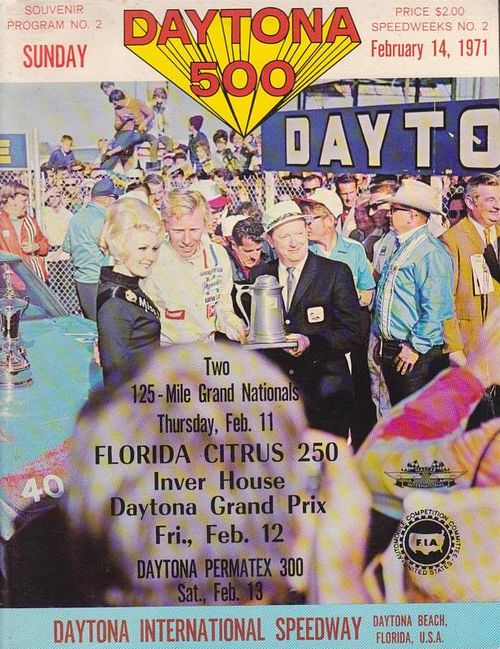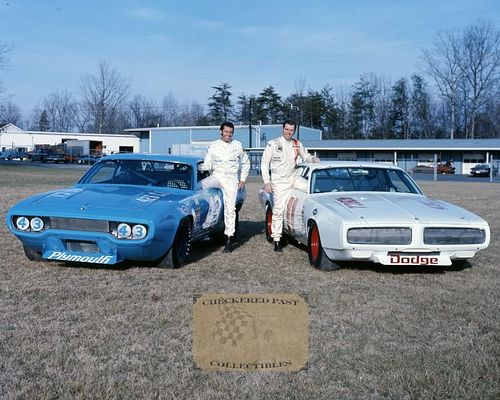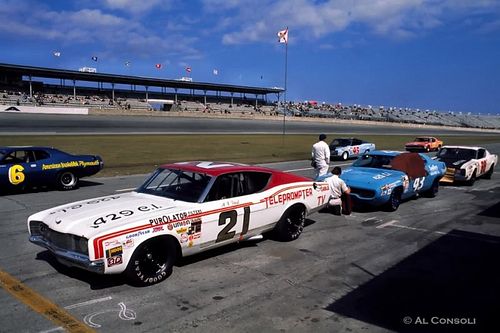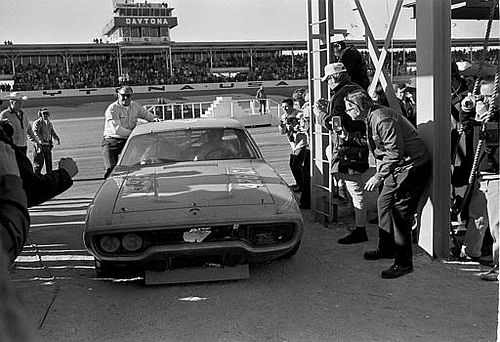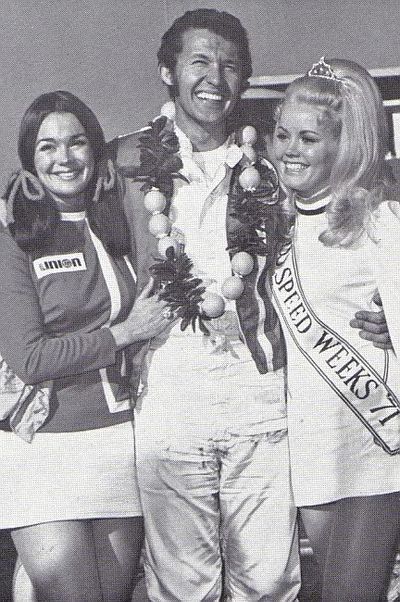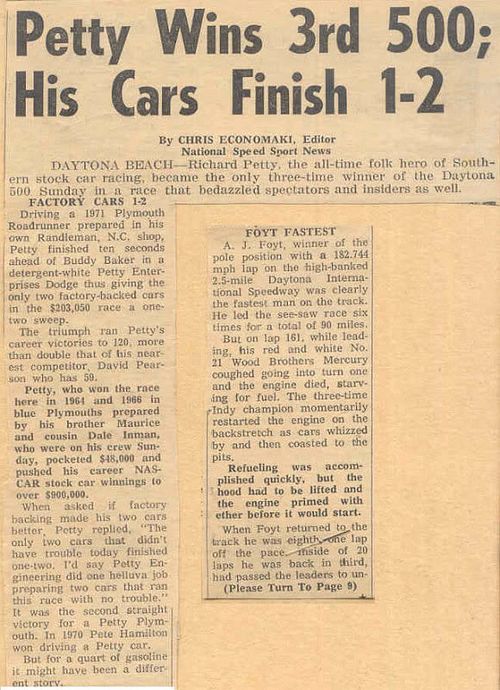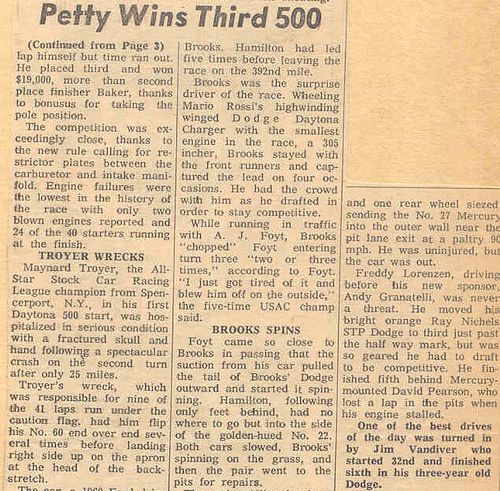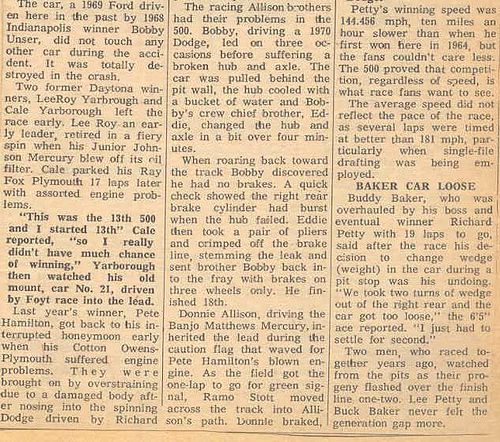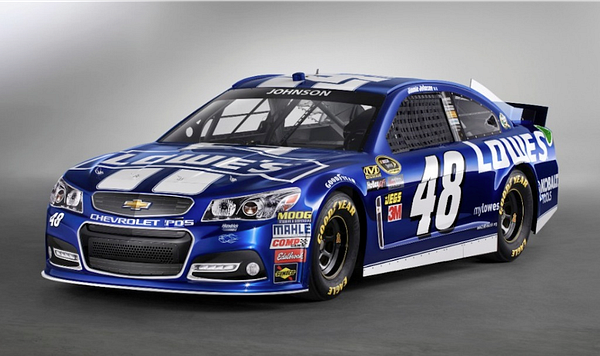Racing History Minute - 1973 Daytona 500
Stock Car Racing History
I originally blogged about the 1973 Daytona 500 in 2012 - with a primary focus on its winner: King Richard.
http://bench-racing.blogspot.com/2012/02/february-18-this-day-in-petty-history.html
I'll repeat much of it here - but expand it more for the rest of the race and Speedweeks in general.
--------
February 18, 1973 - Richard Petty wins his fourth Daytona 500 to capture his 149th career Winston Cup / Grand National victory.
Race program from Motor Racing Programme Covers
Unlike some of his other Daytona wins, Petty didn't dominate the 1973 race. He led only 17 of 200 laps. Petty's teammate in 1971-72, Buddy Baker, moved to the K&K Insurance #71 Dodge in the fall of 1971. When the new season returned to Daytona, Baker won the pole and led over 150 laps of the race. - Richard Guido
In the ARCA Royal Triton 300, Charlie Blanton was the winner. Finishing 18th was N.D. Copley, father of RR member David Copley .
The feel good story of Speedweeks came in the qualifying twins. Pole-winner Baker also won his twin as expected. But in the second twin, long-time independent driver from Columbia TN, Coo Coo Marlin, brought his Cunningham-Kelly Chevrolet under the checkers in first place for the first and only time in his GN/Cup career. Unfortunately, he was two years too late for the win to count officially as a Winston Cup victory. Nonetheless, the win was a popular one for all. - Ray Lamm .
Just 3 years removed from his magical, unexpected win at Daytona, Pete Hamilton was back in the 500 but for the final time. As he had been in his previous starts at the speedway, Pete was FAST off the truck. He qualified second to Baker. Unfortunately, that's where his racing luck ended. He lost an engine in the 125 and finished 27th. He still made the 500 but finished 40th with a second blown engine after only 33 laps. Afterwards, he'd run just one more Cup race in his career. Here he is racing RR's Dave Marcis in Roger Penske's Matador.
1972 Daytona 500 winner, A.J. Foyt, returned to defend his title. Rather than race for the Wood Brothers who had latched onto a good 'un in David Pearson, Foyt entered his own car. Both he and Pearson had sponsorship from Purolator. Perhaps because he wasn't a NASCAR regular, Foyt's runs in the 500 were a bit overshadowed. Petty won the 500 twice in 3 years, but Foyt finished 3rd in 1971, 1st in 1972 and 4th in 1973. Not too shabby.
Another who had a pretty good 500 was Cotton Owens. In 1972, his car with driver Charlie Glotzbach finished 2nd on seven cylinders to Foyt. And in 1973, driver Dick Brooks finished 3rd behind Petty and 2nd place finisher Bobby Isaac.
Bill Dennis won the Permatex 300 Sportsman race for the second consecutive year.
Another entrant was modified star and future NASCAR Hall of Famer, Richie Evans. He didn't have a career day, however, as he finished 34th in the 40-car field. - Ron Wetzler
Yet Evans finished one spot ahead of another NASCAR Hall of Famer, Darrell Waltrip. DW readied two cars for the beach - a #95 Mercury for the 500 and his P.B. Crowell owned #48 Chevelle for the Sportsman race. He raced the same car to many wins on Saturday nights under the lights on Nashville's short-track. - Randy Binkley
In the Main Event, Baker dominated and led with 12 laps to go. King was second right behind him though he'd only led a handful of laps up until then. Under green, Petty made an aggressive run down pit road, locked the tires, hit his pit box perfectly, got fuel only, and headed back out in less than 10 seconds. A lap later, Baker made a more conservative trip down pit road, smoothly entered his pit, got his fuel, and drove away. But the approach and exit strategies made a difference as Petty then had the lead.
As Baker came back to speed, he started chopping into the 43's lead. With six laps to go and Petty's bumper in his crosshairs, Baker's Dodge puked a motor. His day was done, and Petty cruised the last five laps for his fourth 500 win. Baker needed another seven years before he could claim his only Daytona 500. My first 500 to see in person was the 1980 race in which Baker finally won the 500 in the #28 Harry Ranier-owned Oldsmobile.
Finishing 12th was rookie of the year candidate Waltrip. Yep, Ol' DW now known as the FOX announcer who annoys us with his Boogity, Boogity, Boogity bit made his debut Daytona 500 start in 1973. To notch his top 15 finish, Waltrip survived a near miss of a spin and wall-smack by another Daytona rookie - Marty Robbins. Ray Lamm
Another Cup rookie in 1973 - and the one who eventually claimed the season's Rookie Of The Year title, Lennie Pond - failed to even make it to Daytona much less race in it. As Dave Fulton posted here one year ago , Pond got caught in a snow storm and never even made it to Florida.
Hershel McGriff finished 5th in a #04 Plymouth. While fielded under the name of Beryl Jackson as the car's owner, the car was a second Petty Enterprises-prepared and crewed Plymouth.
A victory is always special - but a kiss from your sponsor Andy Granatelli? Ehh, not so much. - Richard Guido
But hoisting your daughter in victory lane. Now, that indeed is a memorable moment for both. - SMJ cover from Jerry Bushmire
And in what may be my favorite Daytona victory lane photo, Granatelli showed how truly larger than life he could be. He bear hugged Richard in victory lane, grabbed Lee Petty's beret and put it on his own head, hammed it up with the pretties for photos, shed his jacket, and almost lost his shirt as he raucously doused himself with champagne.
Bud Lindemann hosted a weekly 'magazine' racing show called Car & Track in the 1960s and 70s. The following is a recap of the race in a bit less than 5 minutes using coverage from one of C&T's episodes.
For about 10 minutes more coverage from the race, view these two clips from Bud's show.
NSSN cover from Russ Thompson, article from Jerry Bushmire.
| Fin | Driver | Sponsor / Owner | Car |
| 1 | Richard Petty | STP (Petty Enterprises) | '73 Dodge |
| 2 | Bobby Isaac | Sta-Power Engine Conditioners (Bud Moore) | '73 Ford |
| 3 | Dick Brooks | John Naughton Insurance (Cotton Owens) | '73 Dodge |
| 4 | A.J. Foyt | Purolator (A.J. Foyt) | '73 Chevrolet |
| 5 | Hershel McGriff | K.D. Pauley (Beryl Jackson) | '72 Plymouth |
| 6 | Buddy Baker | K & K Insurance (Nord Krauskopf) | '72 Dodge |
| 7 | James Hylton | Hylton Engineering (James Hylton) | '71 Mercury |
| 8 | Ramo Stott | Truxmore Industries (Junie Donlavey) | '71 Mercury |
| 9 | Buddy Arrington | Arrington Racing (Buddy Arrington) | '72 Dodge |
| 10 | Vic Parsons | JetWay Products (Bill Seifert) | '71 Mercury |
| 11 | David Sisco | McGee Racing (Charlie McGee) | '72 Chevrolet |
| 12 | Darrell Waltrip | Terminal Transport (Darrell Waltrip) | '71 Mercury |
| 13 | Joe Frasson | Krager Motor Homes (Joe Frasson) | '73 Dodge |
| 14 | Larry Smith | Carling Black Label (Harley Smith) | '71 Mercury |
| 15 | Jabe Thomas | Robertson Racing (Don Robertson) | '73 Dodge |
| 16 | Frank Warren | Rossmeyer (Frank Warren) | '73 Dodge |
| 17 | Ed Negre | Negre Racing (Ed Negre) | '71 Mercury |
| 18 | Ray Elder | Olympia Beer (Fred Elder) | '72 Dodge |
| 19 | Walter Ballard | HeKimian Foreign Cars (Vic Ballard) | '72 Chevrolet |
| 20 | Ron Keselowski | Keselowski Racing (Roger Lubinski) | '72 Dodge |
| 21 | Cecil Gordon | Gordon Racing (Cecil Gordon) | '72 Chevrolet |
| 22 | Cale Yarborough | Kar-Kare (Richard Howard) | '73 Chevrolet |
| 23 | Maynard Troyer | Nagle Ford (Joe Nagle) | '73 Ford |
| 24 | John Utsman | G.C. Spencer | '72 Dodge |
| 25 | Bobby Allison | Coca-Cola (Bobby Allison) | '73 Chevrolet |
| 26 | J.D. McDuffie | McDuffie Racing (J.D. McDuffie) | '71 Chevrolet |
| 27 | Dave Marcis | AMC (Roger Penske) | '73 Matador |
| 28 | Jim Vandiver | Bradford Enterprises (O.L. Nixon) | '72 Dodge |
| 29 | Coo Coo Marlin | Cunningham-Kelley (H.B. Cunningham) | '72 Chevrolet |
| 30 | Benny Parsons | DeWitt Racing (L.G. DeWitt) | '72 Chevrolet |
| 31 | John Sears | J. Marvin Mills Heating & Air (J. Marvin Mills) | '73 Dodge |
| 32 | Red Farmer | Long-Lewis (Willie Humphries) | '72 Ford |
| 33 | David Pearson | Purolator (Wood Brothers) | '71 Mercury |
| 34 | Marty Robbins | Marty Robbins (Marty Robbins) | '72 Dodge |
| 35 | Bill Dennis | Emrick (H.J. Brooking) | '72 Chevrolet |
| 36 | Tiny Lund | Price Construction (Carl Price) | '72 Chevrolet |
| 37 | Neil Castles | Howard Furniture (Neil Castles) | '72 Dodge |
| 38 | Gordon Johncock | Ellington Racing (Hoss Ellington) | '72 Chevrolet |
| 39 | Earl Ross | Red Cap Ale (Allan Brooke) | '73 Chevrolet |
| 40 | Pete Hamilton | Housby Mack Inc. (Jack Housby) | '72 Plymouth |
updated by @tmc-chase: 02/18/19 11:26:46AM
